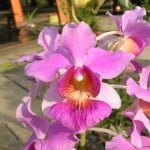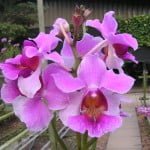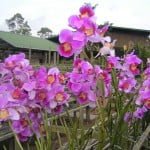Papilionanthe is the old name for this particular variety of Vanda with spiny stems and leaves. With the recent introduction of Vanda Miss Joaquim in our newsletter, I thought it might be appropriate to show more pictures since there’s limited space on our newsletter. =)
Papilionanthe are easy to grow here in Singapore. In fact, its one of the easiest orchid to grow in the tropics. Without any need for media and thriving on relatively low maintenance as compared to many other varieties of orchids. You can just tie one of these to your fence or railing to have them grow and flower. Papilionanthe orchids have meither an age limit nor height limit, the large it grows, the more flower it produces. It can withstand strong xerophytic conditions, and in fact needs strong sunlight in order to flower well.
Attached below is a gallery of Papilionanthe hybrids, they may look similar from far but click on the pictures individually and you will be surprised at how different one may look from the other.
How to grow Papilionanthe?
In the past, Papilionanthe are grown by typing them to a stake or wooden stump in the garden in a bright sunny spot. Tie a number of stems to the stump with equidistant spacing of about 8cm apart based on the size of the support. This is to ensure that each plant receives sufficient sunlight. Other methods of growing includes tying to a fence or railing as mentioned earlier. Providing this orchid plant with support is vital to achieve long sprays of flowers. With a good support, this orchid can reach massive heights and produce a greater number of flowers per spray.
Unlike most of the other orchids that we grow, more organic fertilizers can be applied for the growing of Papilionanthe. Many growers use readily available manure for growing them in the early days when cow, pig and chicken farms are still abundant in Singapore. It is good to keep the base of the plant constantly moist (not wet) during hot days. This allows the plant to take in more water & nutrient easily and thus produce longer sprays of flower.
Pests for Papilionanthe are relatively few due to its spiny stems and leaves which reduces surface area for attack. However. its soft flowers are susceptible to attacks of insects such as caterpillars, beetles and aphids. Periodic spraying of neem oil during the flowering season should do the trick of warding these off.




























Hi Silverelf,
I’m glad to have this site as to broading my idea on growing up an orchids plant. However it would be great if you can provide an articles which talk more about vanda topic..
regards,
Ganie
Hi Ganie,
We have posted new articles on how to grow Vanda as requested. Hope that it helps! =)
silverelf
hi silverelf
how does the original Vanda Miss Joaquim compare with vanda teres hybrid 27 in terms of size and shape, speed of growth and price.
another thing is in regards to the height. as mention it will only flower after the supports. if height extend too much after the support and that increasing the support height is not possible, does trimming hurt the re bloom.
regards.
Hi Yee Fong,
Sorry for the belated reply, noticed somehow I missed replying to your comment when browsing back through the comments. Unfortunately, these Vanda teres hybrid are no longer available for sale as most of them are sold out. The specifications you’ve mentioned are different for each plant as they are derived from seedpod germination. Better priced hybrids are those with good symmetrical forms, grows fast vegetatively, large and lasting flowers but these will usually be selected out for cloning upon first flowering. The remaining ones are similarly priced.
The plant will grow taller faster when provided with support. Without support, the plant may bend and grow messy. Trimming down the plant and planting it again will usually require about 3 – 6 months for the plant to grow new roots and recover to its original state.
silverelf
I have problem with my vanda. Can you please advise.
The whole stem turn brown. Appreciate your advise on this.
Refer to this link for the picture.
http://imageshack.us/photo/my-images/338/vandaupclose2.jpg/
http://imageshack.us/photo/my-images/802/vandaupclose1.jpg/
http://imageshack.us/photo/my-images/402/vanda1.jpg/
Hi Anakcili,
The browning of the stem is common in this type of Vanda as the plant grows old. This browning process may also be sped up if the plant is not well taken care of. You can also try replanting the Vanda with its top cuts. Do also note that this type of Vanda requires lots of sunlight.
silverelf
Hi silverelf. I would like to drop by your nursery to have a look. I am interested in getting some Papilionanthe cuttings or seedlings/flasks, particularly the species. Do you stock species like pedunculata, hookeriana or teres? May I know the price range? Thank you.
Hi Paphioboy,
We have many Papilionanthe hookieriana and teres hybrids.
Most of which are backcrossed with Papilionanthe Miss Joaquim, our national flower.
silverelf
Hi Silverself,
You seems to use the word “Vanda” and “Papilionanthe” interchangeably. There is also another word spelled as “Papilionanda”. Can you explain to me if these names are the same and if not, what exactly do they refer to ? Thanks.
Hi Aaron,
Papilionanthe used to be called Vanda until there’s a taxonomic shift of the names to Papilionanthe. Papilionanda = Papilionanthe x Vanda
silverelf
Thanks for the explnanation on Papilionanthe and Papilionanda. Are teres and hookeriana Vanda or Papilionanthe ?
Hi silverself,
I recently bought a pot of P. Miss Joaquim from this nursery. It is in a charcoal media. How would you suggest watering & fertilising this orchid? Usually for the rest of my orchids, I soaked the roots for a few mins. Thank you in advance for your help.
I live in California and I am interested in buying many of your vanda teres hybrids. How do I go about ordering some from your beautiful company.
Thank you
Hi Nurul,
Its fine to soak the orchids roots for a few mins for P. Miss Joaquim.
We fertilize ours twice a week.
silverelf
Hi Keani,
Kindly refer here for more information.
http://tohgarden.com/export-policy/
silverelf
[…] http://tohgarden.com/vanda/papilionanthe/ […]
Hi,my Vanda Miss Joaquim stem seems to have become softer and whithered.Looks like have shrunk.Is it not enough water?Do I need to water twice a day?
Hello Linda,
This might not be an issue of insufficient water.
It can be due to insufficient sunlight, the plant is not making enough food.
Move it to some where brighter.
It can also be due to damaged roots impeding water uptake.
Check that the roots are not affected by fungus.
The problem should clear up after new roots are sprouted by the plants to absorb water.
silverelf